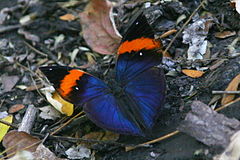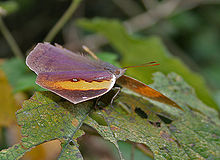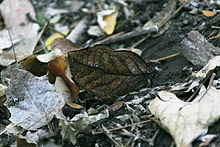- Kallima inachus
-
Orange Oakleaf Scientific classification Kingdom: Animalia Phylum: Arthropoda Class: Insecta Order: Lepidoptera Family: Nymphalidae Genus: Kallima Species: K. inachus Binomial name Kallima inachus
(Boisduval, 1846)The Orange Oakleaf or Dead Leaf (Kallima inachus) is a nymphalid butterfly found in tropical Asia from India to Japan. With wings closed, it closely resembles a dry leaf with dark veins and is a spectacular example of camouflage.
Contents
Description
For the terminology used, see glossary of Lepidopteran terms.The dry and wet season butterflies differ in colouration.
The dry-season form
The fore wing discoidal cell, interspace 1a, 1 to near apex, basal half of 2, and extreme bases of 3 and 4 rich violet-blue, the borders of the discocellulars and the interspaces of veins 2, 3 and 4 are black, spread diffusely outwards in interspaces 1a and 1. A very broad oblique discal orange band from costa to apices of interspaces 1 and 2, this orange band is sprinkled with bluish black scales ; apical third of wing velvety purpurescent black; a hyaline transverse spot near middle of interspace 2, and a subtriangular similar small preapical spot. Hind wing more uniform violescent blue ; the costal margin and apex very broadly brown, somewhat densely irrorated with dusky violescent black scales ; dorsal margin brown ; a ridge of long brownish hairs along vein 1 spreading on to the dorsal margin. Fore and hind wings crossed by a subterminal dusky zigzag line commencing about the middle of interspace 3 in the fore wing, and most conspicuous on the hind wing.
Underside very closely resembles a dry leaf ; ground-colour very variable, but usually some shade of brown (rusty, greyish, and yellowish browns being the most common), always with scattered dark dots or little dark patches having the appearance of fungus-like or lichenous growths so common on dead leaves in the tropics. When the insect closes its wings over its back the likeness to a dead leaf is most striking, and is heightened by a straight transverse, narrow, dark band running from the apex of the fore to the tornus of the hindwing, often with oblique narrower similar bands or lines given off from it, all simulating very closely the midrib and lateral veins of a leaf. The hind wing in all specimens has a more or less obsolescent or faint series of postdiscal ocelli, traces of which are also apparent on the fore wing. Antennae dark brown; head, thorax, and abdomen dark violescent brown; beneath, the palpi, thorax and abdomen paler earthy brown.
Wet-season form
Smaller than the dry-season form, but very similar to it. The colours are richer and darker, and the orange discal band more broadly bordered with black on the inner side. On the underside some of the specimens from areas of heavy rainfall have the ground-colour very dark ochraceous brown.[1]
Distribution
The Himalayas, from Kashmir to Sikkim at low elevations; Orissa; Eastern Ghats; Pachmarhi, Amarkantak; the lower hills of Assam, Burma, and Tenasserim.[1]
Life cycle
Food plants
The larvae feed on plants such as Girardinia diversifolia (Urticaceae), Polygonum orientale (Polygonaceae), Prunus persica (Rosaceae), Hygrophila salicifolia (Acanthaceae ), Lepidagathis formosensis (Acanthaceae) and species of Strobilanthes (Acanthaceae) including Strobilanthes capitatus, Strobilanthes flaccidifolius, Strobilanthes glandulifera, Strobilanthes pentastemonoides, Strobilanthes tashiroi.[2]
Larva
"Velvety black, covered with rather long yellowish hair. All the spines reddish." Of these last it is stated that there are eleven on each segment, a dorsal, two subdorsal and three lateral on each side.[1]
Pupa
"Simple. Thorax slightly keeled ; abdomen with small dorsal conical points. Colour pale brownish buff, variegated with slaty irrorations." (G. C. Dudgeon quoted by Frederic Moore)[1]
Gallery
-
Dry-season form at Samsing in Darjeeling district of West Bengal, India.
-
Dry-season form at Samsing in Darjeeling district of West Bengal, India.
-
Dry-season form at Samsing in Darjeeling district of West Bengal, India.
-
Dry-season form at Samsing in Darjeeling district of West Bengal, India.
See also
References
- Darby, Gene (1958). What is a Butterfly. Chicago: Benefic Press. p. 30.
Categories:- Kallimini
- Fauna of Pakistan
- Butterflies of India
-
Wikimedia Foundation. 2010.







